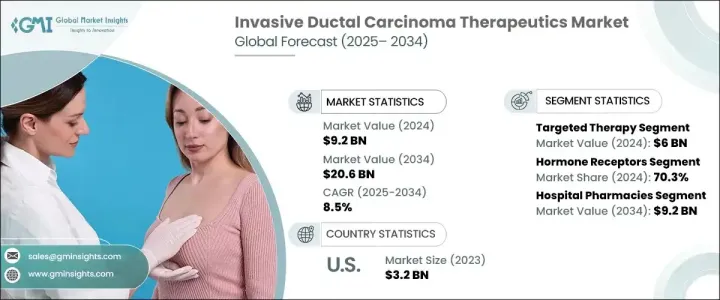PUBLISHER: Global Market Insights Inc. | PRODUCT CODE: 1721474

PUBLISHER: Global Market Insights Inc. | PRODUCT CODE: 1721474
Invasive Ductal Carcinoma (IDC) Therapeutics Market Opportunity, Growth Drivers, Industry Trend Analysis, and Forecast 2025 - 2034
The Global Invasive Ductal Carcinoma Therapeutics Market was valued at USD 9.2 billion in 2024 and is projected to grow at a CAGR of 8.5% to reach USD 20.6 billion by 2034. This robust growth outlook is fueled by the consistently rising prevalence of breast cancer worldwide, with invasive ductal carcinoma being the most frequently diagnosed subtype. IDC accounts for nearly 80% of all invasive breast cancer cases, making it a significant area of focus in oncology. As breast cancer screening programs expand and early detection improves, healthcare providers are witnessing a notable increase in the number of IDC diagnoses. This, in turn, continues to drive demand for effective, patient-centric therapies that not only improve survival rates but also enhance the quality of life. The growing burden of cancer has accelerated the need for treatment innovation, and the IDC therapeutics space is rapidly evolving to meet that need with advanced solutions. Increasing awareness among patients and clinicians, favorable reimbursement scenarios, and expanding healthcare infrastructure across developed and emerging economies are also contributing to this market's sustained momentum.

While conventional chemotherapy remains a key component in managing IDC, the shift toward innovative and targeted therapies is gaining speed. Hormone-based therapies and biologics are becoming the preferred treatment options due to their enhanced efficacy and reduced toxicity profiles. Therapies such as aromatase inhibitors and selective estrogen receptor degraders (SERDs) are especially effective in hormone receptor-positive (HR+) IDC cases, which represent a significant portion of diagnoses. These treatments are helping patients achieve better disease control with fewer side effects, prompting both physicians and patients to lean toward such advanced approaches. As a result, targeted therapeutics are becoming an indispensable element in IDC care protocols, further reinforcing the market's upward trajectory.
| Market Scope | |
|---|---|
| Start Year | 2024 |
| Forecast Year | 2025-2034 |
| Start Value | $9.2 Billion |
| Forecast Value | $20.6 Billion |
| CAGR | 8.5% |
The IDC therapeutics market is segmented by end-use into hospitals, oncology clinics, and other healthcare facilities. Hospitals are expected to generate USD 3.6 billion by 2034, owing to their ability to provide integrated cancer care, state-of-the-art diagnostic systems, and access to multidisciplinary oncology teams. These environments support comprehensive management of complex treatment regimens involving chemotherapy, immunotherapy, and precision medicines, thereby remaining the go-to option for IDC treatment.
In North America, the U.S. holds a leading share of the invasive ductal carcinoma therapeutics market, backed by the region's high disease prevalence and strong healthcare framework. The presence of renowned cancer treatment centers and widespread access to novel therapeutics are driving the adoption of IDC treatments.
Leading companies in this space include AbbVie, AstraZeneca, Bristol-Myers Squibb, Celldex Therapeutics, Eli Lilly, F. Hoffmann-La Roche, Janssen Pharmaceuticals, Macrogenics, Merck, Novartis, and Pfizer. These players are investing heavily in R&D to introduce cutting-edge immunotherapies and combination therapies that deliver better clinical outcomes and fewer side effects.
Table of Contents
Chapter 1 Methodology and Scope
- 1.1 Market scope and definition
- 1.2 Research design
- 1.2.1 Research approach
- 1.2.2 Data collection methods
- 1.3 Base estimates and calculations
- 1.3.1 Base year calculation
- 1.3.2 Key trends for market estimation
- 1.4 Forecast model
- 1.5 Primary research and validation
- 1.5.1 Primary sources
- 1.5.2 Data mining sources
Chapter 2 Executive Summary
- 2.1 Industry 3600 synopsis
Chapter 3 Industry Insights
- 3.1 Industry ecosystem analysis
- 3.2 Industry impact forces
- 3.2.1 Growth drivers
- 3.2.1.1 Increasing prevalence and awareness of breast cancer
- 3.2.1.2 Improved diagnostic technologies
- 3.2.1.3 Expanding therapeutic options
- 3.2.2 Industry pitfalls and challenges
- 3.2.2.1 High treatment cost
- 3.2.2.2 Side effects and resistance to certain therapies
- 3.2.1 Growth drivers
- 3.3 Growth potential analysis
- 3.4 Regulatory landscape
- 3.5 Pipeline analysis
- 3.6 Porter’s analysis
- 3.7 PESTEL analysis
Chapter 4 Competitive Landscape, 2024
- 4.1 Introduction
- 4.2 Company matrix analysis
- 4.3 Competitive analysis of major market players
- 4.4 Competitive positioning matrix
- 4.5 Strategy dashboard
Chapter 5 Market Estimates and Forecast, By Drug Type, 2021 - 2034 ($ Mn)
- 5.1 Key trends
- 5.2 Targeted therapy
- 5.2.1 Abemaciclib
- 5.2.2 Ado-trastuzumab emtansine
- 5.2.3 Everolimus
- 5.2.4 Trastuzumab
- 5.2.5 Ribociclib
- 5.2.6 Palbociclib
- 5.2.7 Pertuzumab
- 5.2.8 Olaparib
- 5.2.9 Other targeted therapies
- 5.3 Hormone therapy
- 5.3.1 Selective estrogen receptor modulators (SERMs)
- 5.3.2 Aromatase inhibitors
- 5.3.3 Selective estrogen receptor degraders (SERDs)
- 5.4 Chemotherapy
- 5.5 Immunotherapy
Chapter 6 Market Estimates and Forecast, By Type, 2021 - 2034 ($ Mn)
- 6.1 Key trends
- 6.2 Hormone receptor
- 6.3 HER2+
- 6.4 Triple-negative breast cancer (TNBC)
Chapter 7 Market Estimates and Forecast, By End Use, 2021 - 2034 ($ Mn)
- 7.1 Key trends
- 7.2 Hospitals
- 7.3 Oncology clinics
- 7.4 Other end use
Chapter 8 Market Estimates and Forecast, By Region, 2021 - 2034 ($ Mn)
- 8.1 Key trends
- 8.2 North America
- 8.2.1 U.S.
- 8.2.2 Canada
- 8.3 Europe
- 8.3.1 Germany
- 8.3.2 UK
- 8.3.3 France
- 8.3.4 Italy
- 8.3.5 Spain
- 8.3.6 Netherlands
- 8.4 Asia Pacific
- 8.4.1 China
- 8.4.2 Japan
- 8.4.3 India
- 8.4.4 Australia
- 8.4.5 South Korea
- 8.5 Latin America
- 8.5.1 Brazil
- 8.5.2 Mexico
- 8.5.3 Argentina
- 8.6 Middle East and Africa
- 8.6.1 South Africa
- 8.6.2 Saudi Arabia
- 8.6.3 UAE
Chapter 9 Company Profiles
- 9.1 AbbVie
- 9.2 AstraZeneca
- 9.3 Bristol-Myers Squibb Company
- 9.4 Celldex Therapeutics
- 9.5 Eli Lilly and Company
- 9.6 F. Hoffmann-La Roche
- 9.7 Gilead Sciences
- 9.8 Janssen Pharmaceuticals
- 9.9 Macrogenics
- 9.10 Merck
- 9.11 Novartis
- 9.12 Pfizer




